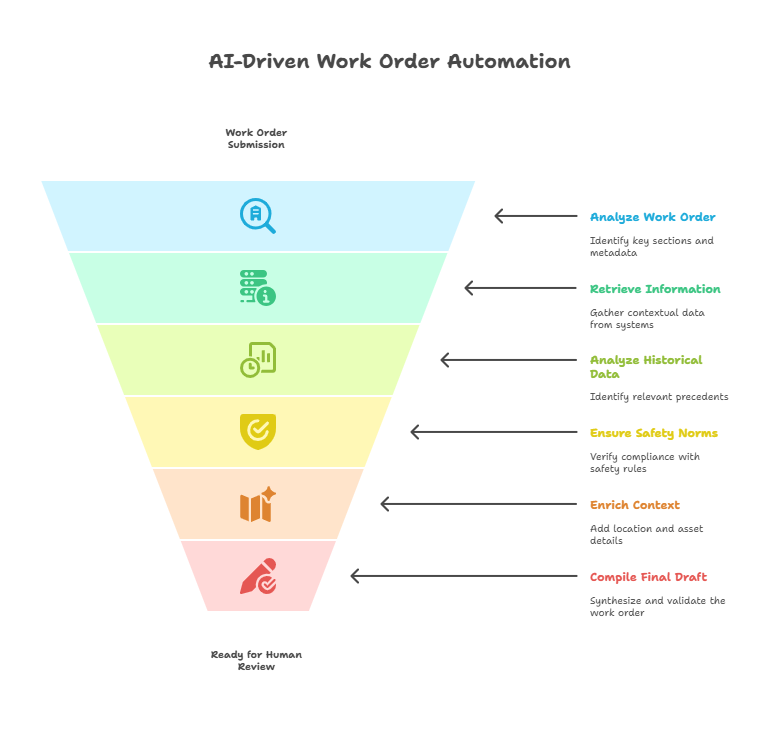Dairyland Power Cooperative, a mission-driven electric utility serving the Upper Midwest, has long been recognized for delivering reliable energy with a strong commitment to safety and operational excellence. In line with its innovation agenda, Dairyland set out to modernize a critical yet time-consuming function, work order management. As field operations expanded, manual work order processing became a significant bottleneck, slowing execution, increasing administrative overhead, and elevating compliance risks.
The problem: manual, error-prone work order processing in utility workflows
As a large electric utility, Dairyland handles hundreds of work orders that must comply with stringent safety standards and coordination across departments. However, the existing WO process was heavily manual. Each work order had to be reviewed for completeness, checked against internal safety rulebooks, enriched with relevant contextual data from systems like Dynamics 365, and verified before execution.
This required back-and-forth between departments, introduced delays, and left room for human error, especially in mission-critical situations. There was no intelligent system to cross-reference safety protocols, validate content, or ensure all required data was included. For a safety-first electric utility, this meant operational inefficiencies and elevated compliance risks. Dairyland needed a robust solution that could automate the end-to-end WO process, ensuring accuracy, compliance, and faster turnaround times.
The solution: multi-agent AI system for work order automation
GoML developed a 5-week proof of concept, introducing a multi-agent AI-powered work order automation system tailored for electric utility workflows. The platform leveraged Lyzr Studio, Azure-native components, and internal APIs to streamline the entire WO lifecycle.
Agent 1: Work order analyzer
Ingests the submitted work order (PDF/Word) and breaks it down to identify key sections, extract metadata, and highlight missing or inconsistent information. It initiates the downstream orchestration process.
Agent 2: Information retrieval orchestrator
Coordinates the retrieval of relevant contextual information from internal systems, safety rulebooks, and past work orders. This agent acts as the central intelligence that distributes tasks to specialized agents.
Agent 3: Previous work order analyzer
Analyzes historical work orders to identify relevant precedents, formatting styles, language references, and contextual examples that could enhance the current WO.
Agent 4: Safety norms retriever
Pulls applicable safety norms and operational procedures from Dairyland’s internal rulebooks and checklists. This ensures the work order adheres to compliance and safety-first principles.
Agent 5: Context enricher
Integrates insights from NATF operating experience reports and industry-wide event analyses to contextualize the work order, ensuring alignment with reliability standards, best practices, and historical performance data.
Agent 6: Final draft compiler and validator
Synthesizes inputs from all other agents to generate the final draft of the work order. It performs a final truthfulness and completeness check before making the WO available for human review and approval.

The impact: 70% reduction in manual effort with intelligent work order automation
- 70% reduction in manual WO handling time
- Built-in safety compliance via automated enrichment agents
- Seamless integration with Dynamics 365 F and O for real-time data access
- Reduced risk and turnaround time in critical field operations
Lessons for utility providers considering work order automation
Common pitfalls to avoid
- Treating work orders as static forms rather than dynamic, safety-critical assets
- Delaying compliance checks until the end
- Over-relying on human coordination for document completeness
Tips for innovation and ops teams
- Train AI agents using past WOs to spot gaps early
- Build enrichment flows directly into the document lifecycle
- Integrate APIs from internal systems for automated, context-rich WOs
Ready to modernize your electric utility workflows with Gen AI?
GoML helps utilities like yours build AI-powered systems that make work order automation safe, efficient, and scalable.
→ Get started with your first intelligent work order automation prototype in just 3 weeks.





